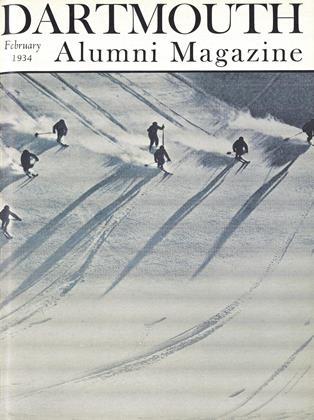THE APPROACH to the arts in America is often devious and odd. The youthful Dreiser wrotedime novels. Spaulding, as a young man, took hisviolin to Russia, where a sporting goods companywas never heard of. Werner Janssen '21 found TinPan Alley a stepping stone to conducting symphonicmusic in Europe. Bellows played baseball, neverwent to Europe, and painted America. Paul Sample'2O returned from the World War to shortly afterward suffer a disability, that forced him from normal life to a retreat in the Adirondacks, whefe hepicked up a paint brush and started the patient prelude to a career.
This was a strange approach to painting and astriking departure from Sample's former life. AtDartmouth he was on the varsity football squad, wasa member of the basketball team, and heavyweightboxing champion in 1921. During the war he servedoverseas as ensign in the Navy. From a world of activity, he was compelled to accept the role of onlooker. The urge to paint and association with JonasLie carried him again to an active way of living.Later, after briefly studying in New York, Samplemoved to California. Here he studied with Wright,brother of S.S. Van Dine, in a studio over a fish pier,and here the apprenticeship yielded the first signs ofsuccess.
Sample imitated no popular style; he stubbornlymade his own with a fine independence. From aninnate sense of composition, he developed his tech-nique to express with integrity his reflection of lifein design. Although living in a region of bright,hard light and pretty palm trees, he ignored thefacile subjects, and painted marines of subtle moodand sea tones. His marines of Fish Harbor and vicinity, in tones of silver and gray, express the delicatelight of dawn without misty nonsense. His Inner Harbor was awarded honorable mention by theChicago Institute, 1930. As Sample's style of painting shifted from impressionism to realism, hepainted unfamiliar phases of the California scene.His Dairy Ranch received the second Hallgartenprize when shown with Mexican Quarter at the National Academy in 1931. And the Isidor Medal, forthe best figure composition, was given to his painting Unemployment.
His work is no more confined to California thanit is to the studio. He is a painter much abroad. Hisliking for small country circuses has produced canvases of the romance of tent shows and clowns. Recently, figures have assumed an arresting place inhis landscapes. These figures against a sharply detailed background are portrayed with movementand vigor, and infuse his latest pictures with drama.This dramatic element is impressively exhibited in Celebration, a robust painting of moments of relaxation in the oil fields. His summer sketching inVermont represents still another interest. From Vermont came Church Supper, a droll painting of rurallife, purchased by the New Springfield Museum inthe fall of 1933. New York will see Paul Sample'sfirst one man show in the East in the Spring of 1934at the Farargil Gallery.
 View Full Issue
View Full Issue
More From This Issue
-
 Class Notes
Class NotesClass of 1929
February 1934 By Frederick William Andres -
 Class Notes
Class NotesClass of 1910
February 1934 By Harold P. Hinman -
 Article
ArticleHANOVER BROWSING
February 1934 By Rees H. Bowen -
 Class Notes
Class NotesClass of 1918
February 1934 By Allan C. Gottschaldt -
 Class Notes
Class NotesClass of 1908
February 1934 By Laurence W. Griswold -
 Article
ArticleA LIFE OF FREEDOM
February 1934 By Paul Starrett Sample '20







